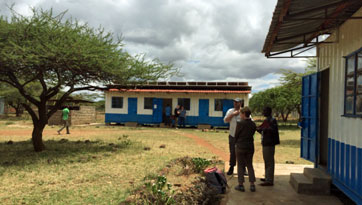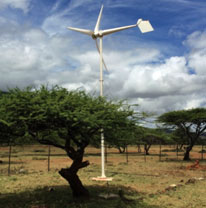Rates of electricity access in Sub-Saharan Africa continue to be extremely low, even compared to other developing regions. The International Energy Agency (IEA) estimated in 2011 that just under half of the total global population lacking access to electricity lives in Sub-Saharan Africa, amounting to almost 600 million people. The situation in Kenya is not atypical for many countries in Sub-Saharan Africa. Electrification rates in rural areas are estimated to be between 5-10% and the national grid operated by the public utility Kenya Power is already operating beyond capacity, causing rolling blackouts as well as in some cases nationwide blackouts.
Alternative pathways to universal electrification hence need to be found. Electrification through grid-independent, renewable energy mini and micro grids will be one important solution. In fact, the IEA estimates that, if universal electrification is to be achieved, 45% of new electricity connections until 2030 will be in the form of mini and micro grids. While there is no clear definition for what constitutes a micro or mini grid it is usually considered to be a system ranging from 5kw to 500kw generating capacity, connecting between ten and a few hundred households and businesses.
One important aspect of mini grid electrification is the engagement of the local community, enabling them to understand how a micro grid works, what it can and cannot do and what changes it will likely bring to the community. A development practitioner in Nairobi told me: "Make them aware of what you introduce to them. You are introducing change in a community, basically. If people didn’t have clothing and you bring in bundles of clothing from somewhere you don’t expect them to start wearing them." Similarly there should be a degree of community ownership in order to improve chances for long-term sustainability. This can range from full ownership and management of the micro grid and its asset all the way to just partial ownership through the contribution of, for example, labour in the construction process ("sweat capital"). Either way, the community must feel the system is theirs and have a sense of pride and responsibility for it. Or, as the same interviewee put it: "They know 'We spent money on it. And if this thing doesn’t work then it is our money we are loosing.' So the moment you pay for something you take care of it. If you don’t pay for it, you don’t care about it."
 Olosho-Oibor, which I got a chance to visit as part of a Nairobi-based workshop for the Solar Nano-Grids (SONG) Project under the Low Carbon Energy for Development Network (LCEDN), is a really interesting example of a fully community-owned and –operated micro grid. It was installed in June 2009 by the United Nations Industrial Development Organisation (UNIDO) with the community of Olosho-Oibor contributed about KSH 60,000 (£400) in capital as well as "sweat capital" by helping to, for example, bury the distribution lines underground. The micro grid connects to the dispensary, which serves 8,000 people in the area, the school with 400 students and the church. It also serves a small flexible business space, which is used as a shop, a barber shop and a cell phone and LED lantern charging station as well as a few nearby households. The micro grid provides a focal point for the local community, which is quite dispersed due to the pastoral nature of their livelihood.
Olosho-Oibor, which I got a chance to visit as part of a Nairobi-based workshop for the Solar Nano-Grids (SONG) Project under the Low Carbon Energy for Development Network (LCEDN), is a really interesting example of a fully community-owned and –operated micro grid. It was installed in June 2009 by the United Nations Industrial Development Organisation (UNIDO) with the community of Olosho-Oibor contributed about KSH 60,000 (£400) in capital as well as "sweat capital" by helping to, for example, bury the distribution lines underground. The micro grid connects to the dispensary, which serves 8,000 people in the area, the school with 400 students and the church. It also serves a small flexible business space, which is used as a shop, a barber shop and a cell phone and LED lantern charging station as well as a few nearby households. The micro grid provides a focal point for the local community, which is quite dispersed due to the pastoral nature of their livelihood.The system originally consisted of 3kWp (kilowatt peak) of solar photovolatic panels (PV), connected to a battery bank, a 3kW wind turbine, with a separate battery bank and a 10kW diesel generator, which can charge both battery banks. At a later stage the United Nations Development Programme (UNDP) Small Grants Programme contributed another 4kWp of solar panels to the system. Before this expansion there was not enough power to support even the basic energy needed to run computers in the school and dispensary, TVs, light public buildings, and charge mobile phones and lanterns.
The system is run by a community-based organization (CBO), which employs a dedicated manager responsible for the operation of the grid. Electricity access is not metered but the system is essentially "open" and there are monthly flat fees per household or business connection that the manager collects, as well as flat fees for charging cell phones or other appliances. Given the limited capacity of the system, the community hence had to come up with other ways of managing demand. As a result of community meetings they have agreed upon a system whereby, when it is overcast or there is very little wind, they disconnect the non-essential consumers first, such as households or the shop, so they can continue to provide electricity to the to essential public institutions. In a sense they have hence come together as a community to collectively manage a limited resource – a form of collective action. In a new STEPS Centre Working Paper I explore the theoretical foundations for collective action in such community micro grids.
A lot more research remains to be done on scalable and replicable business models for these community-based micro grids as almost all existing projects so far could be considered pilots. Having seen the example of Olosho-Oibor, however, which has been operating for five years under community management, there exists a huge opportunity in Kenya and possibly many other parts of Sub-Saharan Africa to provide electricity access to large amounts of the rural population not through the somewhat rigid national grids that the developed countries are so used to, but rather by creating many smaller systems that are specifically tailored to local needs and resource availability and operated locally. In the future these systems could begin to interconnect and form a highly flexible and resilient grid powered largely by renewable energy. This would represent a leapfrogging development straight to the kinds of systems we are now beginning to build in the developed world in order to integrate more and more intermittent renewable energy sources into the grid. There is a long way to go but rural communities in Kenya might be making the first steps.
By Lorenz Gollwitzer
Lorenz Gollwitzer is a PhD student at STEPS Centre co-host SPRU (Science Policy Research Unit), at the University of Sussex
Find out more
- STEPS Working Paper: Community-based Micro Grids: A common property resource problem by Lorenz Gollwitzer
- Resources: STEPS Centre energy and climate change work

